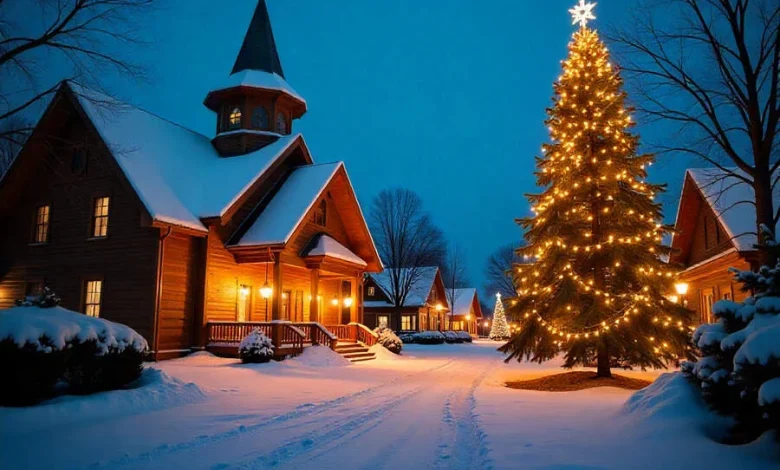Finland Tourism Sees Record Growth As Shuffling Tourist Groups Flood Santa Claus Village In Rovaniemi, Pushing Over One Million Visitors In 2023 Amid Over-Tourism Concerns

Published on
November 17, 2025
Finland tourism is facing a significant overcrowding challenge as Rovaniemi, the official hometown of Santa Claus, saw a record-breaking 1.2 million visitors in 2023, a 30% increase from the previous year. The surge in tourist numbers, driven by new flight routes and the enduring appeal of Santa Claus Village, has led to concerns about over-tourism and its impact on local infrastructure and sustainability. While tourism provides a vital economic boost, the rapid growth of visitors is beginning to strain the town’s resources, prompting discussions on how to balance economic gains with preserving the authenticity and charm that make Rovaniemi so attractive.
Rovaniemi, a serene town nestled in the heart of Finnish Lapland, has long been heralded as the “official hometown of Santa Claus.” Every year, tourists flock to this magical destination on the edge of the Arctic Circle, seeking winter adventures, reindeer sleigh rides, and, of course, a chance to meet Saint Nick. However, with more than 1.2 million visitors flocking to Rovaniemi in 2023, Finland’s tourism industry is now grappling with the complex realities of over-tourism, raising concerns about the sustainability of this beloved destination.
Santa Claus Village: A Winter Wonderland for the Ages
Shuffling across icy ground on a crisp December afternoon, the town of Rovaniemi transforms into a bustling winter paradise. Visitors from around the globe pour into Santa Claus Village, a theme park nestled just south of the Arctic Circle. The site draws tourists year-round, but it’s during the holiday season that the village truly comes alive. Here, families and friends come together to frolic in the snow, embark on exhilarating reindeer sleigh rides, sip cocktails at the ice bar, and experience the magic of meeting Santa Claus himself.
The Santa Claus Village theme park, which is particularly popular during the festive months, attracts more than 600,000 visitors annually. These tourists come from all corners of the world, especially European countries like France, Germany, and the UK. The village has become a key part of Finland’s tourism economy, contributing significantly to Rovaniemi’s appeal as a global winter destination.
However, the allure of Santa Claus Village isn’t just confined to December. The park’s charm extends throughout the year, offering travelers a unique and enchanting experience regardless of the season. This year, a record 1.2 million overnight visitors passed through Rovaniemi’s doors—an impressive 30% growth from 2022. As Finland’s tourism industry continues to recover from pandemic disruptions, these figures highlight the growing global demand for the region’s winter attractions.
The Strain of Over-Tourism in Rovaniemi
While the surge in tourist numbers has undeniably boosted the local economy, it has also raised serious concerns among residents and local officials. Over-tourism, a phenomenon in which the sheer volume of visitors harms the environment and quality of life for local inhabitants, has become an issue in many popular travel destinations across Europe. From Barcelona to Florence, cities that once thrived on tourism are now struggling with the impacts of mass visitation. And Rovaniemi is no exception.
In 2023, Rovaniemi experienced its highest visitor numbers to date. The town has seen an influx of international tourists, helped in part by the addition of thirteen new flight routes to Rovaniemi Airport. The opening of these routes—connecting Rovaniemi to cities such as Geneva, Berlin, and Bordeaux—has made it easier for European tourists to access the region. Most tourists, however, continue to come from France, Germany, and the UK, though the town’s appeal has begun to spread further, with visitors arriving from far-flung places.
The downside to this growth, however, is the overwhelming pressure it puts on the town’s infrastructure. The increased visitor numbers have led to congestion in popular tourist areas, including Santa Claus Village, with locals and visitors alike noticing the strain on public services and accommodations. Finnish law, which prohibits professional accommodation services in residential buildings, has further complicated the situation. The rise in short-term rentals, such as those offered through platforms like Airbnb, has been met with mixed reactions, with some locals celebrating the extra income and others arguing that it contributes to the overcrowding problem.
Local Responses and Concerns Over Sustainability
As Rovaniemi grapples with the growing number of visitors, local authorities are beginning to face difficult decisions about how to balance tourism with sustainability. Mayor Ulla-Kirsikka Vainio has acknowledged that tourism is an essential revenue source for the town, and many local businesses are thriving as a result. However, she has also highlighted the need to ensure that tourism does not overwhelm the town’s infrastructure or degrade the very experiences that visitors are coming to enjoy.
Indeed, the challenge for Rovaniemi, as with many other tourist-heavy destinations, lies in finding the right balance between supporting the local economy and protecting the environment, culture, and lifestyle of the town’s residents. With Rovaniemi being situated on the Arctic Circle, the region faces unique challenges when it comes to managing tourism. The surrounding natural environment is fragile, and the growing number of visitors could pose a risk to the very resources that draw tourists in the first place.
Sustainability and the Future of Finland’s Tourism
The Finnish government has acknowledged the importance of addressing over-tourism and ensuring that Finland’s tourism industry remains sustainable. Finland has long been a leader in eco-tourism, with an emphasis on preserving the country’s natural beauty and cultural heritage. However, as the country continues to attract increasing numbers of visitors, there is growing pressure to develop sustainable travel practices that can benefit both the economy and the environment.
In response to this issue, various initiatives are being considered to curb the negative impacts of over-tourism in Rovaniemi and beyond. Local tourism boards are looking at ways to promote more sustainable forms of travel, such as eco-friendly accommodations and transport options, and working to encourage tourists to visit during the off-season, when there is less strain on the infrastructure.
One promising solution is the promotion of Finland’s many other natural attractions beyond Rovaniemi. The country is home to vast wilderness areas, charming villages, and unique cultural experiences that have yet to experience the same level of mass tourism. By spreading the tourist traffic across different regions, Finland can help to alleviate the pressure on Rovaniemi and other popular spots, while offering visitors a more authentic and less crowded experience.
Moreover, Finnish tourism operators are focusing on developing year-round attractions that will draw visitors in all seasons, not just during the winter months. These initiatives aim to create a more balanced and sustainable tourism economy that can support local communities while preserving the integrity of Finland’s landscapes and cultural assets.
The Role of Local Communities in Shaping the Future of Tourism
Ultimately, the future of tourism in Rovaniemi and other Finnish towns will depend on the active involvement of local communities. While tourism can bring significant economic benefits, it is essential that local residents have a say in how tourism is managed and that their needs and concerns are addressed. By engaging with local communities, tourism boards, and businesses, Finland can ensure that its tourism industry continues to thrive without sacrificing the quality of life for its residents.
The story of Rovaniemi is a cautionary tale for many other destinations around the world. As tourism numbers continue to rise, the question of sustainability must remain at the forefront of any conversation about the future of global travel. Finland, with its strong commitment to environmental protection and sustainable practices, has an opportunity to lead the way in showing how tourism can thrive while remaining respectful of the natural environment and local communities.
Finland’s tourism industry is at a crossroads. While the record-breaking growth in Rovaniemi is a testament to the region’s global appeal, it also serves as a stark reminder of the challenges posed by over-tourism. The balance between economic growth and environmental preservation is delicate, and Finland must continue to prioritize sustainability in its tourism policies.
Finland tourism is facing overcrowding in Rovaniemi as record-breaking 1.2 million visitors flocked to Santa Claus Village in 2023, driven by new flight routes and growing global demand. This surge has raised concerns about the strain on local infrastructure and sustainability.
For Rovaniemi, the solution lies in developing a more sustainable approach to tourism—one that respects both the town’s residents and the natural environment that makes it so special. By promoting responsible travel, investing in infrastructure, and encouraging visitors to explore beyond the traditional tourist hubs, Finland can set a new standard for tourism in the 21st century. Only through careful planning and collaboration can Finland ensure that its winter wonderland remains a magical destination for generations to come.





